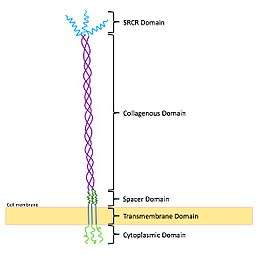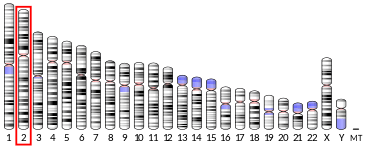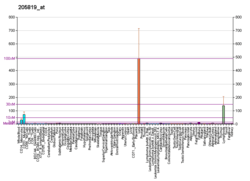MARCO
Macrophage receptor MARCO also known as macrophage receptor with collagenous structure (MARCO) is a protein that in humans is encoded by the MARCO gene.[5][6][7][8] MARCO is a class A scavenger receptor that is found on particular subsets of macrophages.[9][10][11] Scavenger receptors are pattern recognition receptors (PRRs) and are most commonly found on immune cells.[10] Their defining feature is that they bind to polyanions and modified forms of a type of cholesterol called low-density lipoprotein (LDL).[9][10] MARCO is able to bind and phagocytose these ligands and pathogen-associated molecular patterns (PAMPs), leading to the clearance of pathogens as well as causing downstream effects in the cell that lead to inflammation.[11][12] As part of the innate immune system, MARCO clears, or scavenges, pathogens and leads to inflammatory responses.[12] The scavenger receptor cysteine-rich (SRCR) domain at the end of the extracellular side of MARCO is responsible for ligand binding and the subsequent immune responses.[12] MARCO expression on macrophages is also associated with diseases since Alzheimer's disease is associated with decreased response within the cell when a ligand binds to MARCO.[13][14]
Cell expression
Certain subtypes of macrophages are likely to express MARCO, but the receptor is also present on circulating monocytes, dendritic cells, and B cells.[10][15] MARCO is typically present on the macrophages in the marginal zone of the spleen and the medullary lymph nodes, but it is also found in the liver.[13] Dendritic cells increase expression of MARCO when exposed to certain pathogens, which leads to an increase in phagocytosis by the dendritic cell.[9] When ligand binds to MARCO on dendritic cells, the cytoskeleton of the cell is altered, allowing for the formation of the long arms that also increase the phagocytic ability of dendritic cells.[9][16] Macrophages that constitutively express MARCO are within the spleen marginal zone and medullary lymph nodes.[9] Certain interactions between the macrophage and bacteria up-regulate its expression, as well as stimulating the expression of MARCO on tissue macrophages.[9][10]
Function
Phagocytosis
The primary function of scavenger receptors is to phagocytose pathogens, but they are also able to participate in cell–cell recognition and are important in initiating inflammatory responses.[11][10] MARCO, being a PRR, is able to bind to a wide variety of bacteria, making it an important receptor for immunity against bacteria.[12] Both soluble LPS and entire bacteria are able to bind to MARCO.[17] MARCO is also able to bind to both acetylated LDL (AcLDL) and oxidized LDL (OxLDL), as well as to B cells in the marginal zone of the spleen and apoptotic cells.[9][10] Since MARCO is able to recognize and phagocytose pathogens and apoptotic cells, expression of MARCO increases the phagocytic ability of the cell. MARCO operates independently of opsonization.[12]
Inflammation
MARCO does not directly cause an inflammatory response, but it helps other receptors interact with PAMPs, so they may initiate inflammation.[11][12] One way MARCO does this is by tethering a pathogen to other proteins on the cell that do cause an inflammatory response.[12] These proteins could be other PRRs such as TLR2.[12] These receptors may then lead to the activation of NF-κB which allows for the production and release of pro-inflammatory cytokines.[12] Through phagocytosis, MARCO also brings pathogens into the cell so that there are more pathogens available to intracellular compartments containing receptors such as TLR3, NOD2, and NALP3 that are capable of initiating an inflammatory response.[11]
Structure

MARCO is a transmembrane protein that has five domains.[10] The first domain is within the cell, called the cytoplasmic domain.[10] Moving into the cell membrane is the transmembrane domain, which is followed by the spacer domain located outside of the cell, then the collagenous domain, and finally the SRCR domain.[10] The SRCR domain is necessary for MARCO to bind to ligands.[10] Other members of the class A scavenger receptors tend to have alpha helical coiled coil domains, but MARCO does not.[9]
The C-terminal SRCR domain of MARCO plays a key role in the ability of the receptor to bind and take up ligand, enhance downstream inflammatory responses, and adhere to surfaces.[12] The SRCR domain is where the ligand binds to MARCO.[12] There are two highly conserved arginine amino acids, called the RxR motif, that are crucial for the binding of the ligand.[12]
Associated diseases
The activity of MARCO on microglia, the macrophages of the brain, is associated with Alzheimer's disease.[11][14] One primary characteristic of Alzheimer's disease is the presence of numerous senile plaques in the brain that contain amyloid beta peptides (Aβ).[14] Initially, the microglia clear the Aβ which binds to receptors such as MARCO.[14] As the disease progresses, however, their ability to clear Aβ decreases, resulting in Aβ accumulation.[14] This accumulation of Aβ occurs early on in Alzheimer's disease, harming the brain as Aβ is neurotoxic.[14] MARCO also interacts with formyl peptide receptor (FPR2) to form a complex that causes the microglia to release pro-inflammatory cytokines which leads to inflammation that results in damage to neurons.[14]
References
- GRCh38: Ensembl release 89: ENSG00000019169 - Ensembl, May 2017
- GRCm38: Ensembl release 89: ENSMUSG00000026390 - Ensembl, May 2017
- "Human PubMed Reference:". National Center for Biotechnology Information, U.S. National Library of Medicine.
- "Mouse PubMed Reference:". National Center for Biotechnology Information, U.S. National Library of Medicine.
- Elomaa O, Sankala M, Pikkarainen T, Bergmann U, Tuuttila A, Raatikainen-Ahokas A, Sariola H, Tryggvason K (February 1998). "Structure of the human macrophage MARCO receptor and characterization of its bacteria-binding region". The Journal of Biological Chemistry. 273 (8): 4530–8. doi:10.1074/jbc.273.8.4530. PMID 9468508.
- Elomaa O, Kangas M, Sahlberg C, Tuukkanen J, Sormunen R, Liakka A, Thesleff I, Kraal G, Tryggvason K (February 1995). "Cloning of a novel bacteria-binding receptor structurally related to scavenger receptors and expressed in a subset of macrophages". Cell. 80 (4): 603–9. doi:10.1016/0092-8674(95)90514-6. PMID 7867067.
- Kangas M, Brännström A, Elomaa O, Matsuda Y, Eddy R, Shows TB, Tryggvason K (May 1999). "Structure and chromosomal localization of the human and murine genes for the macrophage MARCO receptor". Genomics. 58 (1): 82–9. doi:10.1006/geno.1999.5811. PMID 10331948.
- "Entrez Gene: MARCO macrophage receptor with collagenous structure".
- Plüddemann A, Neyen C, Gordon S (November 2007). "Macrophage scavenger receptors and host-derived ligands". Methods. 43 (3): 207–17. doi:10.1016/j.ymeth.2007.06.004. PMID 17920517.
- Bowdish DM, Gordon S (January 2009). "Conserved domains of the class A scavenger receptors: evolution and function". Immunological Reviews. 227 (1): 19–31. doi:10.1111/j.1600-065x.2008.00728.x. PMID 19120472.
- Mukhopadhyay S, Varin A, Chen Y, Liu B, Tryggvason K, Gordon S (January 2011). "SR-A/MARCO-mediated ligand delivery enhances intracellular TLR and NLR function, but ligand scavenging from cell surface limits TLR4 response to pathogens". Blood. 117 (4): 1319–28. doi:10.1182/blood-2010-03-276733. PMID 21098741.
- Novakowski KE, Huynh A, Han S, Dorrington MG, Yin C, Tu Z, Pelka P, Whyte P, Guarné A, Sakamoto K, Bowdish DM (August 2016). "A naturally occurring transcript variant of MARCO reveals the SRCR domain is critical for function". Immunology and Cell Biology. 94 (7): 646–55. doi:10.1038/icb.2016.20. PMC 4980223. PMID 26888252.
- Sun H, Song J, Weng C, Xu J, Huang M, Huang Q, Sun R, Xiao W, Sun C (May 2017). "Association of decreased expression of the macrophage scavenger receptor MARCO with tumor progression and poor prognosis in human hepatocellular carcinoma". Journal of Gastroenterology and Hepatology. 32 (5): 1107–1114. doi:10.1111/jgh.13633. PMID 27806438.
- Yu Y, Ye RD (January 2015). "Microglial Aβ receptors in Alzheimer's disease". Cellular and Molecular Neurobiology. 35 (1): 71–83. doi:10.1007/s10571-014-0101-6. PMID 25149075.
- Getts DR, Terry RL, Getts MT, Deffrasnes C, Müller M, van Vreden C, Ashhurst TM, Chami B, McCarthy D, Wu H, Ma J, Martin A, Shae LD, Witting P, Kansas GS, Kühn J, Hafezi W, Campbell IL, Reilly D, Say J, Brown L, White MY, Cordwell SJ, Chadban SJ, Thorp EB, Bao S, Miller SD, King NJ (January 2014). "Therapeutic inflammatory monocyte modulation using immune-modifying microparticles". Science Translational Medicine. 6 (219): 219ra7. doi:10.1126/scitranslmed.3007563. PMC 3973033. PMID 24431111.
- Kissick HT, Dunn LK, Ghosh S, Nechama M, Kobzik L, Arredouani MS (2014-08-04). "The scavenger receptor MARCO modulates TLR-induced responses in dendritic cells". PLOS One. 9 (8): e104148. doi:10.1371/journal.pone.0104148. PMC 4121322. PMID 25089703.
- Athanasou NA (May 2016). "The pathobiology and pathology of aseptic implant failure". Bone & Joint Research. 5 (5): 162–8. doi:10.1302/2046-3758.55.bjr-2016-0086. PMC 4921050. PMID 27146314.
Further reading
- Elshourbagy NA, Li X, Terrett J, Vanhorn S, Gross MS, Adamou JE, Anderson KM, Webb CL, Lysko PG (February 2000). "Molecular characterization of a human scavenger receptor, human MARCO". European Journal of Biochemistry. 267 (3): 919–26. doi:10.1046/j.1432-1327.2000.01077.x. PMID 10651831.
- Seta N, Granfors K, Sahly H, Kuipers JG, Song YW, Baeten D, Veys EM, Maksymowych W, Märker-Hermann E, Gu J, Huang F, Kirveskari J, Yu DT (April 2001). "Expression of host defense scavenger receptors in spondylarthropathy". Arthritis and Rheumatism. 44 (4): 931–9. doi:10.1002/1529-0131(200104)44:4<931::AID-ANR150>3.0.CO;2-T. PMID 11315932.
- Brännström A, Sankala M, Tryggvason K, Pikkarainen T (February 2002). "Arginine residues in domain V have a central role for bacteria-binding activity of macrophage scavenger receptor MARCO". Biochemical and Biophysical Research Communications. 290 (5): 1462–9. doi:10.1006/bbrc.2002.6378. PMID 11820786.
- Sankala M, Brännström A, Schulthess T, Bergmann U, Morgunova E, Engel J, Tryggvason K, Pikkarainen T (September 2002). "Characterization of recombinant soluble macrophage scavenger receptor MARCO". The Journal of Biological Chemistry. 277 (36): 33378–85. doi:10.1074/jbc.M204494200. PMID 12097327.
- Mirani M, Elenkov I, Volpi S, Hiroi N, Chrousos GP, Kino T (December 2002). "HIV-1 protein Vpr suppresses IL-12 production from human monocytes by enhancing glucocorticoid action: potential implications of Vpr coactivator activity for the innate and cellular immunity deficits observed in HIV-1 infection". Journal of Immunology. 169 (11): 6361–8. doi:10.4049/jimmunol.169.11.6361. PMID 12444143.
- Bin LH, Nielson LD, Liu X, Mason RJ, Shu HB (July 2003). "Identification of uteroglobin-related protein 1 and macrophage scavenger receptor with collagenous structure as a lung-specific ligand-receptor pair". Journal of Immunology. 171 (2): 924–30. doi:10.4049/jimmunol.171.2.924. PMID 12847263.
- Arredouani MS, Palecanda A, Koziel H, Huang YC, Imrich A, Sulahian TH, Ning YY, Yang Z, Pikkarainen T, Sankala M, Vargas SO, Takeya M, Tryggvason K, Kobzik L (November 2005). "MARCO is the major binding receptor for unopsonized particles and bacteria on human alveolar macrophages". Journal of Immunology. 175 (9): 6058–64. doi:10.4049/jimmunol.175.9.6058. PMID 16237101.
- Liu T, Qian WJ, Gritsenko MA, Camp DG, Monroe ME, Moore RJ, Smith RD (2006). "Human plasma N-glycoproteome analysis by immunoaffinity subtraction, hydrazide chemistry, and mass spectrometry". Journal of Proteome Research. 4 (6): 2070–80. doi:10.1021/pr0502065. PMC 1850943. PMID 16335952.




